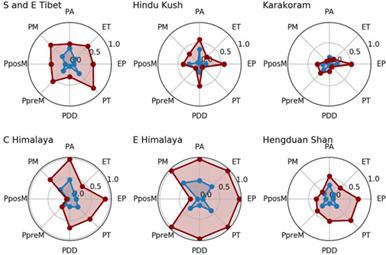当前位置:
X-MOL 学术
›
Int. J. Climatol.
›
论文详情
Our official English website, www.x-mol.net, welcomes your
feedback! (Note: you will need to create a separate account there.)
Using large ensemble modelling to derive future changes in mountain specific climate indicators in a 2 °C and 3 °C warmer world in High Mountain Asia
International Journal of Climatology ( IF 3.5 ) Pub Date : 2020-08-18 , DOI: 10.1002/joc.6742 P. N. J. Bonekamp 1 , N. Wanders 1 , K. Wiel 2 , A. F. Lutz 1 , W. W. Immerzeel 1
International Journal of Climatology ( IF 3.5 ) Pub Date : 2020-08-18 , DOI: 10.1002/joc.6742 P. N. J. Bonekamp 1 , N. Wanders 1 , K. Wiel 2 , A. F. Lutz 1 , W. W. Immerzeel 1
Affiliation

|
Natural disasters in High Mountain Asia (HMA) are largely induced by precipitation and temperatures extremes. Precipitation extremes will change due to global warming, but these low frequency events are difficult to analyse using (short) observed time series. In this study we analysed large 2000 year ensembles of present day climate and of a 2 °C and 3 °C warmer world produced with the EC-EARTH model. We performed a regional assessment of climate indicators related to temperature and precipitation (positive degree days, accumulated precipitation, (pre and post-) monsoon precipitation), their sensitivity to temperature change and the change in return periods of extreme temperature and precipitation in a 2 and 3 °C warmer climate. Using large ensemble modelling to derive future changes in mountain specific climate indicators in a 2 °C and 3 °C warmer world in High Mountain Asia
中文翻译:

在亚洲高山地区升温 2°C 和 3°C 的世界中,使用大型集合模型推导出山区特定气候指标的未来变化
亚洲高山 (HMA) 的自然灾害主要是由降水和极端温度引起的。由于全球变暖,极端降水会发生变化,但这些低频事件很难使用(短)观测时间序列进行分析。在这项研究中,我们分析了由 EC-EARTH 模型产生的 2000 年的大型现代气候集合以及温度升高 2°C 和 3°C 的世界。我们对与温度和降水相关的气候指标(正度日、累积降水、(前和后)季风降水)、它们对温度变化的敏感性以及极端温度和降水重现期的变化进行了区域评估。和 3 °C 的温暖气候。
更新日期:2020-08-18
中文翻译:

在亚洲高山地区升温 2°C 和 3°C 的世界中,使用大型集合模型推导出山区特定气候指标的未来变化
亚洲高山 (HMA) 的自然灾害主要是由降水和极端温度引起的。由于全球变暖,极端降水会发生变化,但这些低频事件很难使用(短)观测时间序列进行分析。在这项研究中,我们分析了由 EC-EARTH 模型产生的 2000 年的大型现代气候集合以及温度升高 2°C 和 3°C 的世界。我们对与温度和降水相关的气候指标(正度日、累积降水、(前和后)季风降水)、它们对温度变化的敏感性以及极端温度和降水重现期的变化进行了区域评估。和 3 °C 的温暖气候。











































 京公网安备 11010802027423号
京公网安备 11010802027423号